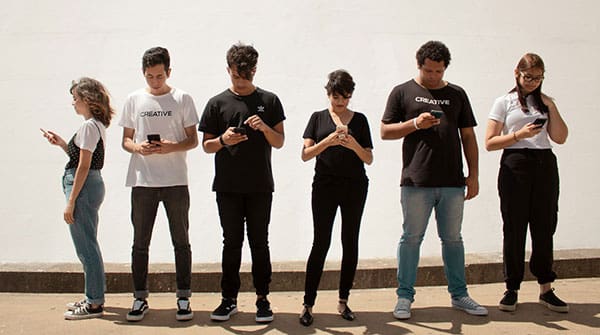When you’re old enough to drive, you’re old enough to have a smartphone. Not before
 Schools aren’t the safe haven we’d like them to be. Students have access to many unhealthy options within its walls, such as junk food and drugs. The Toronto District School Board’s latest attempt at limiting students’ ability to cause self-harm is the creation of a new policy that would restrict students’ use of smartphones while in class, undoing a ban the TDSB enacted in 2007 and revoked in 2011.
Schools aren’t the safe haven we’d like them to be. Students have access to many unhealthy options within its walls, such as junk food and drugs. The Toronto District School Board’s latest attempt at limiting students’ ability to cause self-harm is the creation of a new policy that would restrict students’ use of smartphones while in class, undoing a ban the TDSB enacted in 2007 and revoked in 2011.
It doesn’t take a wild imagination to envision what teachers are up against these days. Teachers are dealing with distractions, disruptions, and loss of focus associated with students using smartphones in class. Imagine trying to teach a student whose boyfriend broke up with her via text or assisting one student during a test while other students are photographing the test. In addition, teachers are dealing with students drowsy from screen-induced sleep deprivation.
Even when put away in their locker or knapsack, the student’s phone continues to inhabit their mind. They fret over what’s happening in their digital world, whether a BFF had left a consoling text, whether a fellow cheater sent last period’s exam questions, what names you’d been called and how many likes their last post garnered.
 Photo by Creative Christians |
| Related Stories |
| Top 8 warning signs your smartphone is infected with spy apps
|
| How digital media is altering perceptions of Gaza
|
| Is my iPhone snooping on my conversations?
|
Smartphones pull – not just for students – as hard as magnets and seem to vibrate with expectancy when you merely look at them. Undeniably, getting students’ attention is more challenging today because they’re perpetually distracted and emotionally overstimulated, unlike when I was a student back in my day. On social media platforms, behind the backs of teachers and staff, drama, conflict, bullying, and adolescent scandals are being played out throughout the school day.
Smartphones don’t just pull students away from schoolwork; they also pull them away from one another.
A significant way smartphones have negatively impacted relationships is through “phubbing” (a contraction of phone snubbing), the act of checking a phone during a conversation. Adults are just as complicit of phubbing as are “the youth.” Phubbing undermines a currently happening physical, social interaction by conveying, “My phone is more important than you.”
You don’t need stats, only casual observations, to see that today, people give a fraction of their attention to the person they’re with. This explains why people who are the heaviest users of phones or social media are also the most depressed and lonely. Once a few students begin phubbing, the other students feel pressure to pull out their own smartphones, and voila, the entire school’s culture changes from students engaging with each other to walking the hallways with their heads down, staring at their phones.
A person’s school years are a time to develop social skills – get over teenage angst – and make friendships that’ll last a lifetime, not to avoid social interactions by using your smartphone to look “popular” and “busy.”
Parents, particularly, praised TDSB’s proposed crackdown, flooding the school board with messages of support. Unsurprisingly, some parents wanted to be able to communicate with their children during the day. You’d think parents would prioritize learning over unfettered access to their kids 24/7. Then were those who pragmatically warned that a ban would be a headache to enforce – boiling down to whether students would comply, not likely, and whether teachers would be willing to take on the burden of enforcing – and that a better option is to teach kids how to use technology safely and not influence their mental landscape.
I’m of the school (pun intended) of thought that our educators are gravely negligent in not formally educating students, beginning in Grade Five, on how to use smartphones and navigate social media platforms responsibly. The issue that keeps being ignored is that social media apps aren’t designed to be used in moderation or responsibly. These devices are designed to be highly addictive, making it hard for teachers to compete with such distractions. The challenge is compounded by addicted parents without usage restrictions, making a smartphone ban appear unjust.
Hopefully, we can agree on one positive benefit of banning smartphones in schools: Schools being a phone-free zone would create more brain space for engaging academically and socially. If we want children to be present while in school, do well, cultivate friendships, and feel like they belong, we wouldn’t allow smartphones and social media to dominate our student’s school day. Unfortunately, achieving this ideal isn’t possible because it isn’t a priority with educators and parents; therefore, educating students and conducting classes in Social Media 101, 102 and 103 is the next best option.
I may be oversimplifying, but given how powerful and potentially damaging smartphones are, parents – ultimately, it’s not educators’ responsibility to raise their children – might want to seriously consider treating their kids’ having access to a smartphone like having access to car keys: When you’re old enough to drive, you’re old enough to have a smartphone.
Nick Kossovan, a self-described connoisseur of human psychology, writes about what’s on his mind.
For interview requests, click here.
The opinions expressed by our columnists and contributors are theirs alone and do not inherently or expressly reflect the views of our publication.
© Troy Media
Troy Media is an editorial content provider to media outlets and its own hosted community news outlets across Canada.
